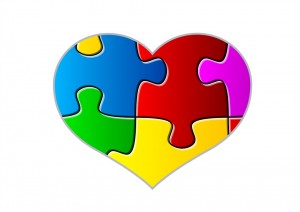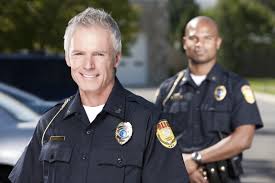I am one of millions of people whose life has been touched by somebody with an autism spectrum disorder (ASD). I work with individuals who have autism, both children and adults, mostly in their homes and out in the community. On a regular basis when I am with my clients, we are stared at, and occasionally have been confronted in regards to certain behaviors, such as making loud noises, jumping up and down, pacing back and forth in line and accidentally nudging into others, etc. Most of the time, however, I receive a warm smile or knowing glances from others in the  community–which is truly a testament to how far the autism awareness movement has come to date. The outside world can quickly become over-stimulating for a person with ASD, which at times leads to a public meltdown. Occasionally, these meltdowns involve physical aggression of some sort (from slapping or pinching to hitting, etc.). When this happens, I become immediately anxious- not anxious out of concern for myself, as I have been trained for safety in incidents like these. I become concerned as to how this looks to the people around. I worry that people will begin to crowd around us (fairly common), which inevitably enhances the severity of the meltdown. I worry, like so many others who care for individuals with autism, that a concerned citizen will think there is a danger being posed, call law enforcement, and that police will arrive and perhaps not recognize the signs of autism and respond in such a way that, unknowingly and unintentionally, escalates the situation further. I understand that law enforcement follows a specific protocol for responses, but I worry that if these responses are used on a person with ASD, they could fight back, flee, or be seriously injured in the case of a restraint situation.
community–which is truly a testament to how far the autism awareness movement has come to date. The outside world can quickly become over-stimulating for a person with ASD, which at times leads to a public meltdown. Occasionally, these meltdowns involve physical aggression of some sort (from slapping or pinching to hitting, etc.). When this happens, I become immediately anxious- not anxious out of concern for myself, as I have been trained for safety in incidents like these. I become concerned as to how this looks to the people around. I worry that people will begin to crowd around us (fairly common), which inevitably enhances the severity of the meltdown. I worry, like so many others who care for individuals with autism, that a concerned citizen will think there is a danger being posed, call law enforcement, and that police will arrive and perhaps not recognize the signs of autism and respond in such a way that, unknowingly and unintentionally, escalates the situation further. I understand that law enforcement follows a specific protocol for responses, but I worry that if these responses are used on a person with ASD, they could fight back, flee, or be seriously injured in the case of a restraint situation.
Of course, all individuals with autism have unique “triggers”, just as every person does. Consequently, is important to remember that generalizations of the signs of autism will always have exceptions. All individuals are at different places on the spectrum and exhibit unique behaviors. In general, however, people who are on the autism spectrum may not make eye contact with others or respond to verbal communication (many individuals on the spectrum are nonverbal), including demands from law enforcement or other authorities. They may also have sensitivities to light, touch, sounds, and so on. People with autism may flee if confronted, for a variety of reasons. These and other behaviors could be construed as acts of willful defiance, guilt of a crime, etc. and end in tragedy.
Why is training needed?
Prevalence rates of autism spectrum disorder (ASD) are high: the CDC estimates that 1 in 68 children is currently on the autism spectrum. Therefore, it is clear that law enforcement employees-including police officers, school resource officers, and trainers—may encounter a child or adult with autism in a variety of situations, perhaps on a  daily basis. For example, individuals with autism spectrum disorder are more prone to wandering away from their homes, caregivers, etc. This creates a unique situation in which law enforcement is sometimes called to help find a missing person with autism. It is important for law enforcement to be able to identify people exhibiting common signs of autism so their response can be tailored to the situation as much as possible, as some standard protocol are not the best practices for interacting with persons with ASD.
daily basis. For example, individuals with autism spectrum disorder are more prone to wandering away from their homes, caregivers, etc. This creates a unique situation in which law enforcement is sometimes called to help find a missing person with autism. It is important for law enforcement to be able to identify people exhibiting common signs of autism so their response can be tailored to the situation as much as possible, as some standard protocol are not the best practices for interacting with persons with ASD.
The responsibility of spreading autism awareness lies with all of us. Prevalence rates are high and expected to continue to increase in the coming years. The main modality of care has shifted from institutional to at home and in the community. Mandated autism awareness training for law enforcement would spread awareness and response information easily to a group charged with protecting and serving the public. This is especially crucial since law enforcement is often first on the scene of any emergency situation.
What can individuals with autism do to minimize risks?
Of course, I am not saying that it is solely the responsibility of law enforcement to spread autism awareness and response strategies. However, this is an important step. In addition to requiring training for law enforcement, it is important that people with autism spectrum disorder learn protocol, to the best of their ability, for interacting with law enforcement and other emergency responders. More information and recommendations for individuals with autism can be found here.
Act now- click here to visit the following website to sign a petition for Attorney General Eric Holder to make autism response training for law enforcement mandatory. Over 18,000 people have already signed this petition. People with autism and other developmental disabilities are important parts of our community, and protecting their safety–as well as that of law enforcement–is all of our responsibility.



1 pings